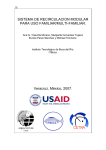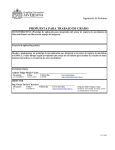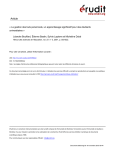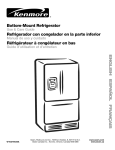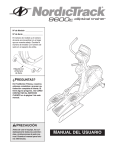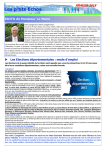Download para descargar pulse aquí
Transcript
REFERENCIAS BIBLIOGRÁFICAS Agencia Española de Seguridad Alimentaria. Ministerio de Sanidad y Consumo. (2005). Estrategia para la Nutrición, Actividad Física y Prevención de la Obesidad, la Estrategia NAOS. Madrid. Ministerio de Sanidad y Consumo. American Psychiatric Association (APA) (1994). Diagnostic and statistical manual of mental disorders (4ª ed.) (DSM-IV). Washington, DC: APA. (Traducción española: Masson, Barcelona, 1995). American Psychiatric Association (APA) (2000). Practice guideline for the treatment of patients with eating disorders (Revision). American Journal of Psychiatry, 157, Suppl. 1-39. American Psychiatric Association (2002). DSM-IV-TR. Manual diagnóstico y estadístico de los trastornos mentales (4ª ed. texto rev.). Barcelona: Masson. (Orig. 2000). American Psychiatric Association. (2013). Diagnostic and statistical manual of mental disorders (5th ed.). Arlington, VA: American Psychiatric Publishing. Anderluh, M., Tchanturia, K., Rabe-Hesketh, S., Collier, D. y Treasure, J. (2009). Lifetime course of eating disorders: design and validity testing of a new strategy to define the eating disorders phenotype. Psychological Medicine, 1, 105-114. Arnow, B., Kenardy, J., y Agras, W. S. (1995). The Emotional Eating Scale: The development of a measure to assess coping with negative affect by eating. International Journal of Eating Disorders, 18, 79-90. Baños, R.M. y Perpiñá, C. (2002). Exploración Psicopatológica. Madrid: Síntesis. Beumont, P.J.V. (2002). Clinical presentation of anorexia nervosa and bulimia nervosa. En C.G. Fairburn y K.D. Brownell (dirs.), Eating Disorders and obesity. A comprehensive Handbook. (pp. 162-170). New York: Guilford Press. Beato, L. y Rodríguez, T. (2003). El cuestionario de actitudes frente al cambio en los trastornos de la conducta alimentaria (ACTA). Desarrollo y propiedades psicométricas. Actas españolas de psiquiatría, 31, 111-119. Beato, L. y Rodriguez, T. (2014). Diagnóstico e indicación terapéutica. En G.Morandé, M. Graell, y M.A. Blanco (Eds.). Trastornos de la conducta alimentaria y obesidad. Un enfoque Integral. (pp.237-240). Madrid. Editorial Médica Panamericana. Beck, A.T. (1976). Cognitive therapy and the emotional disorders. New York: New American Library. Bellace, D.L., Tesser, R., Berthod, S., Wisotzke, K., Crosby, R.D., Crow, S.J, et al., (2012). The Yale-Brown-Cornell Eating Disorders Scale Self-Report Questionnaire: A New, Efficient Tool for Clinicians and Researchers. International Journal of Eating Disorders, 45, 856–860. Belloch, A., Roncero, M. y Perpiñá, C. (2012). Ego-Syntonicity and Ego-Dystonicity Associated with Upsetting Intrusive Cognitions. Journal of Psychopathology and Behavioral Assessment, 34, 94-106. Brownell, K.D. (2010). The humbling experience of treating obesity: Should we persist or desist?. Behaviour Research and Therapy, 48, 717-719. Bruch, H. (1973). Eating disorders: obesity, anorexia nervosa and the person within. New York: Basic Books. Bryant‐Waugh, R.J., Cooper, P.J., Taylor, C. L., y Lask, B.D. (1996). The use of the eating disorder examination with children: A pilot study. International Journal of Eating Disorders, 19, 391-397. Bryant-Waugh, R., Markham, L., Kreipe, R. E., y Walsh, B.T. (2010). Feeding and Eating Disorders in Childhood. International Journal of Eating Disorders, 43, 98-111. Bryant-Waugh, R. y Nicholls, D. (2011). Diagnosis and classification of disordered eating in childhood. En: D. Le Grange y J. Lock. Eating Disorders in children and adolescents. A Clinical Handbook. (pp.107-125). New York: The Guilford press. Bulik, C.M., Sullivan, P.F., Fear, J. y Pickering, A. (1997). Predictors of the development of bulimia nervosa in anorexia nervosa. The Journal of Nervous and Mental Disease 185, 704707. Bulick, C., Sullivan, P., Carter F.A., McIntosh, V.V. y Joyce P.R. (1998). The role of exposure with response prevention in cognitive-behavioral therapy for bulimia nervosa. Psychological Medicine, 28, 611–623. Cardi, V., Krug, I., Perpiñá, C., Mataix, D., Roncero, M., y Treasure, J. (2012). The use of a non immersive virtual reality program in Anorexia Nervosa: a single case-report. European Eating Disorders Review 20, 240-245. Cash, T.F. (1994). The situational inventory of body-image dysphoria: contextual assessment of a negative body image. The behavior Therapist, 17, 133-134. Cash, T.F. (2000). MBSRQ Users’ Manual (3rd revision). www.body-images.com Cash, T.F. y Grant, J.R. (1996). Cognitive-Behavioral treatment of Body-Image disturbances. En V.B. Van Hasselt y M. Hersen, M. (eds.), Sourcebook of psychological treatment manuals for adult disorders. New York: Plenum Press. Cebolla, A., Perpiñá, C., y Botella, C. (2013). Revision of the measures to detect childhood binge eating disorder and other related disordered eating. En S.B. Harris (Ed.,). Binge Eating and Binge Drinking: Psychological, Social and Medical Implication. (pp.187-200). Nova Science Publishers, Inc. Series: Eating Disorders in the 21st Century. Cebolla, A., Barrada, J.R., Van Strien, T., Oliver, E., y Baños, R., (2014). Validation of the Dutch Eating Behavior Questionnaire for Adults (DEBQ) in a Sample of Spanish Females. Appetite, 73, 58-64. Cloninger, C.R. (1987). A systematic method for clinical description and classification of personality variants: a proposal. Archives of General Psychiatry, 44, 573-588. Cooper, Z. y Fairburn, C.G. (2010). Cognitive behavior therapy for bulimia nervosa. En C.M. Grilo y J.E. Mitchell (eds.), The treatment of eating disorders. A clinical handbook. (pp 243270). New York: The Guilford Press. Cooper, P.J., Taylor, M.J., Cooper, Z. y Fairbun, C.G. (1987). The development and validation of the Body Shape Questionnaire. International Journal of Eating Disorders, 6, 485-494. Cooper, Z., Fairburn, C.G., y Hawker, D.M. (2003). Cognitive-Behavioral Treatment of Obesity: A Clinician's Guide. New York: Guilford Press Cooper, Z., Doll, H.A., Hawker, D.M., Byrne, S., Bonner, G., Eeley, E., O’Connor, E. y Fairburn C.G. (2010). Testing a new cognitive behavioural treatment for obesity: a randomized controlled trial with three year follow-up. Behaviour Research and Therapy, 48, 706–713. Craske, M.G. y Barlow, D.H. (2007). Mastery of your anxiety and panic: Therapist guide (4ª ed.). London: Oxford University Press. Crow, S., Peterson, C., Swanson, S., Raymond, N., Specker, S., Eckert, E.D. y Mitchell, J. (2009). Increased mortality in bulimia nervosa and other eating disorders. American Journal of Psychiatry, 166, 1342–1346. Dalmau, J., Franch, A., Gómez, L., Martínez, C. y Sierra, C. (2007). Obesidad infantil. Recomendaciones del comité de nutrición de la asociación española de pediatría. Parte II. Diagnóstico. Comorbilidades. Tratamiento. Anales de Pediatría, 66, 294-304. Davies, W.H., Satter, E., Berlin, K.S., Sato, A.F., Silverman, A.H,, Fischer, E.A., et al. (2006). Reconceptualizing feeding and feeding disorders in interpersonal context: The case for a relational disorder. Journal of Family Psychology, 20, 409–417 de Gracia, M., Marcó, M., y Trujano, P. (2007). Factores asociados a la conducta alimentaria en preadolescentes. Psicothema, 19, 646-653. Derogatis, L. R. (1994). SCL-90-R. Administration, Scoring and Procedures Manual (Third Edition). Minneapolis: National Computer Systems. Devlin, M.J. (2007). Is there a place for Obesity in DSM-V? International Journal of Eating Disorders, 40, S83-S88. Devlin, M.J., Goldfein, J.A. y Dobrow, I. (2003). What is this thing called BED? Current status of binge eating disorder nosology. International Journal of Eating Disorders, 34, 2-18. Diez-Quevedo, C., Rangil, T., Sanchez-Planell, L., Kroenke, K. y Spitzer R.L. (2001). Validation and utility of the patient health questionnaire in diagnosing mental disorders in 1003 general hospital Spanish inpatients. Psychosomatic Medicine, 63, 679-686. Dray, J. y Wade, T.D. (2012). Is the transtheoretical model and motivational interviewing approach applicable to the treatment of eating disorders? A review. Clinical Psychology Review, 32, 558-565. Echeburúa, E. y Marañón, I. (2001). Comorbilidad de las alteraciones de la conducta alimentaria con los trastornos de personalidad. Psicología Conductual, 9, 513-525. Eddy, K.T., Dorer, D.J., Franko, D.L., Tahilani, K., Thompson-Brenner, H., y Herzog, D.B. (2008). Diagnostic crossover in Anorexia Nervosa and Bulimia Nervosa: Implications for DSM-V. American Journal of Psychiatry, 165, 245–250. Elosua, P., López-Jáuregui, A., y Sánchez-Sánchez, F. (2010). Manual técnico con la adaptación al euskera del Eating Disorder Inventory-3. Madrid: TEA Ediciones. Fagundo, A.B., de la Torre, R., Jiménez,S., Agüera,Z., Granero, R., Tárrega, S., Botella, C., Baños, R., Fernández-Real, J.M., Rodríguez, R., Forcano, L., Frübeck, G., y Gómez-Ambrosi, J. (2012). Executive function profile in extreme eating/weight conditions: From anorexia nervosa to obesity. Plos one 7, 1-9. Fairburn, C.G. (1985). Cognitive-behavioral treatment for bulimia. En D.M. Garner y P.E. Garfinkel (eds.), Handbook of psychotherapy for anorexia nervosa and bulimia. New York: Guilford Press. Fairburn, C.G. (1998). La superación de los atracones de comida. Barcelona: Paidós. Fairburn, C.G. (2008). Cognitive Behavior Therapy and Eating Disorders. New York: Guilford Press, Fairburn, C.G. y Cooper, P.J. (1989). Eating Disorders. En K.Hawton, P.M.Salkolvskis, J. Kirk y D.M.Clark (Eds.), Cognitive Behaviour therapy for psychiatric problems. (pp. 277-314). Oxford. Oxford University Press. Fairburn, C.G. y Cooper, Z. (1993). The Eating Disorder Examination: (12th ed.). En C.G. Fairburn, y G.T. Wilson (Eds.), Binge eating: Nature, assessment and treatment. New York: Guilford Press. Fairburn, C.G. y Harrison, P.J. (2003) Eating disorders. Lancet, 361, 407-416 Fairburn, C.G; Cooper, Z. y Shafran, R. (2003). Cognitive behaviour therapy for eating disorders: a “transdiagnostic” theory and treatment. Behaviour Research and Therapy, 41, 509–528. Fairburn, C.G., Marcus, M.D. y Wilson, G.T. (1993). Cognitive-behavioral therapy for binge eating and bulimia nervosa: a comprehensive treatment manual. En C.G. Fairburn, y G.T. Wilson (eds.), Binge eating: Nature, assessment and treatment. New York: Guilford Press. Fairburn, C.G., Cooper, Z; Bohn, K., O’Connor, M.E., Doll, H.A. y Palmer, R.L. (2007). The severity and status of eating disorder NOS: Implications for DSM-V. Behaviour Research and Therapy 45, 1705–1715. Fairburn C.G., Cooper Z., Doll H.A., O'Connor M.E., Bohn K., Hawker D.M., Wales J.A. y Palmer R.L. (2009). Transdiagnostic cognitive-behavioral therapy for patients with eating disorders: a two-site trial with 60-week follow-up. American Journal of Psychiatry, 166, 311319. Fassino, S., Abbate-Daga, G., Amianto, F., Leombruni, P., Boggio, S., y Rovera, G.G. (2001). Temperament and character profile of eating disorders: a controlled study with the Temperament and Character Inventory. International Journal of Eating Disorders, 32, 412425. Favaro, A., Tenconi, E., y Santonastaso, P. (2006). Perinatal factors and the risk of developing anorexia nervosa and bulmia nervosa. Archives of General Psychiatry, 63, 82-88. Fernández-Aranda, F., Jiménez-Murcia, S., Santamaría, J.J., Gunnard, K., Soto, A., Kalapanidas, E., ... y Penelo, E. (2012). Video games as a complementary therapy tool in mental disorders: PlayMancer, a European multicentre study. Journal of Mental Health, 21, 364-374. First, M.B., Spitzer, R.L., Gibbon, M. y Williams, J.B.W. (1997). Structured Clinical Interview for DSM-IV Axis I (SCID-I). Washington: APA Pres Inc. Gandarillas, A., Zorrilla, B., Sepúlveda, A. R., & Muñoz, P. (2003). Prevalencia de casos clínicos de trastornos del comportamiento alimentario en mujeres adolescentes de la Comunidad de Madrid. Madrid: Instituto de Salud Pública. García-Camba, E. (2001). Trastornos de la conducta alimentaria en el momento actual. En E. García-Camba (dir.). Avances en trastornos de la conducta alimentaria. Anorexia nerviosa, bulimia nerviosa, obesidad. (pp. 3-29). Barcelona: Masson. García-Campayo J., Sanz-Carrillo, C., Ibáñez, J.A., Lou, S., Solano, V., Alda, M. (2005). Validation of the Spanish version of the SCOFF questionnaire for the screening of eating disorders in primary care. Journal of Psychosomatic Research, 59, 51-55. García-Soriano, G., Roncero, M., Perpiñá, C. y Belloch, A. (2014). Intrusive Thoughts in Obsessive-Compulsive Disorder and Eating Disorder patients: A differential analysis. European Eating Disorders Review, 22, 191-199 García-Soriano, G., Belloch, A., Morillo, C., y Clark, D.A. (2011). Symptom dimensions in obsessive–compulsive disorder: From normal cognitive intrusions to clinical obsessions. Journal of Anxiety Disorders, 25, 474–482. Gardner, J. y Wilkinson, P. (2011). Is family therapy the most effective treatment for anorexia nervosa. Psychiatr Danub, 23, S175-S177. Garner, D.M. (1991). Eating disorder inventory-2: Professional manual. Odessa, FL: Psychological Assessment Resources. (1998). Inventario de trastornos de la conducta alimentaria (EDI-2). Madrid, España: TEA. Garner, D. M. (2004). Eating Disorder Inventory– 3 Professional manual. Odessa, FL: Psychological Assessment Resources. Garner, D.M. y Bemis, K.M. (1982) A cognitive behavioral approach to anorexia nervosa, Cognitive Therapy and Research, 6, 1-27 Garner, D.M. y Garfinkel, P.E. (1979). The eating attitudes test: an index of symptoms of anorexia nervosa. Psychological Medicine, 9, 273-279. Garner, D.M. y Rosen, L.W. (1990). Anorexia nervosa and bulimia nervosa. En A.S. Bellack, M. Hersen y A.E. Kazdin (eds.), International handbook of behavior modification and therapy (2º ed). New York: Plenum Press. Garner, D.M., Olmstead, M.P. y Polivy,J. (1983). Development and validation of a multidimensional eating disorder inventory for anorexia nervosa and bulimia. International Journal of Eating Disorders, 2, 15-34. Garner, D.M., Vitousek, K.M. y Pike, K.M. (1997). Cognitive-behavioral therapy for anorexia nervosa. En D.M. Garner y P.E. Garfinkel (eds.,). Handbook of treatment for eating disorders, New York. Guilford Press. Garner, D.M., Olmstead, M.P., Bohr, Y. y Garfinkel, P.E. (1982). The eating attitudes test: Psychometric features and clinical correlates. Psychological Medicine, 12, 871-878. Grilo, C. (2002). Binge Eating Disorder. En C.G.Fairburn, y K.D. Brownell (dirs.), Eating disorders and obesity: a comprensive handbook. New York: Guilford Press. Grilo C. (2006). Eating and weight disorder. New York: Guilford Press. Grupo de trabajo de la Guía de Práctica Clínica sobre Trastornos de la Conducta Alimentaria (2009). Guía de práctica clínica sobre trastornos de la conducta alimentaria. Madrid: Plan de Calidad para el Sistema Nacional de Salud del Ministerio de Sanidad y Consumo. Agència d'Avaluació de Tecnologia i Recerca Mèdiques de Cataluña. Guías de Práctica Clínica en el SNS: AATRM Núm. 2006/05-01. Disponible en http://www.guiasalud.es/egpc/conducta_alimentaria/completa/ Habermas, T. (1996). In defense of weight phobia as the central organizing motive in anorexia nervosa: historical and cultural arguments for a culture sensitive psychological conception. International Journal of Eating Disorders, 19, 317-334 Heatherton, T.F. y Polivy, J. (1992). Chronic dieting and eating disorders. A spiral model. En J. Crowther et al., (eds.). The etiology of bulimia: the individual and familiar context. Washington DC: Hemisphere. Henderson, M. y Freeman, C.P.L. (1987). A self-rating scale for bulimia: The BITE. British Journal of Psychiatry, 150, 18-24. Herman, C.P., y Polivy, J. (1980). Restrained eating. En A.J. Stunkard (ed.), Obesity. Philadelfia: P.A. Saunders. Hoek, H.W. y Van Hoeken, D. (2003). Review of the prevalence and incidence of eating disorders. International Journal of Eating Disorders, 34, 383-396. Hollander, E. (2007). Anxiety and OC spectrum disorders over life cycle. International Journal of Psychiatry in Clinical Practice, 11 (suppl. 2), 5-10. Hudson, J.I., Pope, H.G., Jonas, J.M. y Yurgelun-Todd, D. (1983). Phenomenologic relationship of eating disorders to major affective disorder. Psychiatry research, 9, 345-354. Jeffery, R.W. y Levy, R.L. (2010). Overgeneralization from limited data: A commentary on Cooper et al., 2010. Behaviour research and therapy, 48, 714-716. Kasvikis, Y.G., Tsakiris, F., Marks, I.M., Basoglu, M. y Noshirvani, H.F. (1986). Past history of anorexia nervosa in women with obsessive-‐compulsive disorder. International Journal of Eating Disorders, 5(6), 1069-1075. Keys, A., Brožek, J., Henschel, A., Mickelsen, O. y Taylor, H.L. (1950). The biology of human starvation.(2 vols). Klump, K. L., Kaye, W. H. y Strober, M. (2001). The evolving genetic foundations of eating disorders. Psychiatric Clinics of North America, 24, 215-225. Jansen, A., Klaver, J., Merckelbach, H. y van den Hout, M.A. (1989). Restrained eaters and rapidly habituating sensation seekers. Behaviour Research and Therapy, 27, 247–252. Johnson, C. (1985). Initial consultation for patients with bulimia and anorexia nervosa. En D.M. Garner y P.E. Garfinkel, (eds.), Handbook of psychotherapy for anorexia nervosa and bulimia (pp. 19-51). Nueva York. The Guilford Press. Leitenberg, H., Gross, J., Peterson, J., y Rosen, J.C. (1984). Analysis of an anxiety model of the process of change during exposure plus response prevention treatment of bulimia nervosa. Behavior Therapy, 15, 3–20. López, C. y Treasure, J. (2011). Trastornos de la conducta alimentaria en adolescentes: descripción y manejo. Revista Médica Clínica Las Condes, 22, 85–97 López, C.A., Tchanturia, K., Stahl, D. y Treasure, J. (2008). Central coherence in women with bulimia nervosa. International Journal of Eating Disorders, 41, 340-347. Maganto, C. y Cruz, S. (2011). TSA, test de siluetas para adolescentes. Madrid: TEA. Maloney, M.J., McGuire, J.B. y Daniels, S.R. (1988). Reliability testing of a children’s version of the Eating Attitude Test. Journal of the American Academy of Child and Adolescent Psychiatry, 27, 541–543. Marco, J.H., Botella, C. y Perpiñá C. (2006). Los trastornos alimentarios y las nuevas tecnologías: la utilidad de abordar la imagen corporal utilizando técnicas de realidad virtual. En F.Méndez, J.Espada y M.Orgilés (Cords.). Terapia Psicológica con niños y adolescentes. (pp. 257-284). Madrid: Pirámide Marco, J.H., Botella, C. y Perpiñá, C. (2011). Tratamiento de la Imagen Corporal en los Trastornos Alimentarios. Editorial Académica Española. LAP LAMBERT Academic Publishing GmbH & Co. KG Marco J.H., Perpiñá, C. y Botella, C. (2013). Effectiveness of cognitive behavioral therapy supported by virtual reality in the treatment of body image in eating disorders: one year follow-up. Psychiatry Research, 209, 619-625 Marlatt, G.A. y Gordon, J.R. (eds.) (1985). Relapse prevention: Maintenance strategies in the treatment of addictive behaviors. New York: Guilford Press. Martinez‐Mallén, E., Castro‐Fornieles, J., Lázaro, L., Moreno, E., Morer, A., Font, E., ... y Toro, J. (2007). Cue exposure in the treatment of resistant adolescent bulimia nervosa. International Journal of Eating Disorders, 40, 596-601. May, J., Andrade, J., Kavanagh, D. J. y Hetherington, M. (2012). Elaborated Intrusion theory: A cognitive-emotional theory of food craving. Current Obesity Reports, 1, 114-121. Mazure, C.M., Halmi, K.A., Sunday, S.R., Romano, S.J, y Einhorn, A.N. (1994). YaleBrown-Cornell Eating Disorder Scale: development, use, reliability and validity. Journal of Psychiatric Research; 28, 425–445 Mercader, J. M., Ribases, M., Gratacos, M., Gonzalez, J. R., Bayes, M., de Cid, R. et al. (2007). Altered brain-derived neurotrophic factor blood levels and gene variability are associated with anorexia and bulimia. Genes, Brain and Behavior, 6, 706-716. Miller, W.R. y Rollnick, S. (2002). Motivational interviewing: Preparing people for change. New York: Guilford Press. Mora, M. y Raich, R.M. (1993). Adaptació del Bulimia Test i Body Shape Questionnaire en una mostra universitaria. Comunicación presentada en las VIII Jornada de Teràpia del Comportament i Medicina Conductual en la Pràctica Clínica. Barcelona. Morgan, J.F, Reid, F., y Lacey, J.H. (1999). The SCOFF questionnaire: assessment of a new screening tool for eating disorders. British Medical Journal, 319, 1467-1468. Nicholls, D, y Arcelus, J. (2010). Making Eating Disorders Classification Work in ICD-11. European Eating Disorders Review, 18, 247-250. Nicholls, D., Chater, R. y Lask , B. (2000). Children into DSM don’t go: a comparison of classification systems for eating disorders in childhood and early adolescence. International Journal of Eating Disorders, 28, 317-324. Nisbett, R. E. (1972). Hunger, obesity, and the ventromedial hypothalamus. Psychological Review, 79, 433-448. Organización Mundial de la Salud (1992). CIE 10. Trastornos mentales y del comportamiento. Descripciones clínicas y pautas para el diagnóstico. Madrid: Meditor. Palmer, R., Christie, M., Cordle, C., Davis, D. y Kendrick, J. (1987). The clinical eating disorder rating instrument (CEDRI): A preliminary description. International Journal of Eating Disorders, 6, 9-16. Pérez-Gaspar, M., Gual, P., de Irala-Estévez, J., Martínez-González, M.A., Lahortiga, F. y Cervera, S. (2000). Prevalencia de trastornos de la conducta alimentaria en adolescentes navarras. Medicina Clínica, 114, 481-486. Perpiñá, C. (1999). Trastornos alimentarios. Anorexia y Bulimia Madrid: Klinic, Cursos de postgrado en psicopatología y Salud. Madrid: UNED-FUE. Perpiñá, C. (2006). Obesidad infantil y trastornos alimentarios ¿A qué dar prioridad?. Infocop, 27, 26-29; Versión online: http://www.infocoponline.es/view_article.asp?id=559 Perpiñá, C. (2008). Trastornos alimentarios. En A.Belloch, B.Sandín y F. Ramos (dirs.), Manual de psicopatología (vol 1), (pp. 403-422), Madrid: MacGraw-Hill. Edición Revisada Perpiñá, C. (2009, Mayo). Flexibilidad mental y toma de decisiones en pacientes con TCA y TOC. Ponencia presentada en VII Congreso de la Asociación Española para el Estudio de los Trastornos de la Conducta Alimentaria (AEETCA), Palma de Mallorca, España. Perpiñá C. (2014). Trastornos Alimentarios. En V.E. Caballo; I.C Salazar y J.A. Carrobles (Dirs.). Manual de psicopatología y trastornos psicológicos. (2º edición) (pp.605-637) Madrid: Pirámide. Perpiñá, C. y Roncero, M. (2014). Nuevas tecnologías terapéuticas. En G.Morandé, M. Graell, y M.A. Blanco (Eds.). Trastornos de la conducta alimentaria y obesidad. Un enfoque Integral. (pp.453-456). Madrid: Editorial Médica Panamericana. Perpiñá, C., Botella, C. y Baños, R. (2000). Imagen corporal en los trastornos alimentarios. Evaluación y tratamiento mediante realidad virtual. Valencia: Promolibro. Perpiñá, Segura, M. y Sánchez-Reales, S. (enviado para su publicación). Cognitive flexibility and decision making in eating disorders and obesity. Perpiñá, C., Roncero, M., Belloch, A. y Sánchez-Reales, S. (2011). Eating-related Intrusive Thoughts Inventory: exploring the dimensionality of eating disorder symptoms. Psychological Reports, 109, 1-19. Perpiñá, C., Cebolla, A., Botella, C., Lurbe, E. y Torró, M. (2011). Emotional Eating Scale for Children and Adolescents: Psychometric Characteristics in a Spanish Sample. Journal of Clinical Child and Adolescent Psychology, 40, 424-433. Perpiñá, C., Giraldo-O’Meara, M., Roncero, M., y Martínez-Gómez, M. (2015) Confirmatory factor analysis and psychometric properties of the Yale-Brown-Cornell Eating Disorders Scale Self-Report version (SR-YBC-EDS) in Spanish clinical and non-clinical samples. Eating Behaviors, 17, 6-9. Perpiñá, C., Botella, C., Baños, R., Marco, J.H; Alcañiz, M. y Quero, S. (1999). Body Image and virtual reality in eating disorders: Exposure by virtual reality is more effective than the classical body image treatment?. Cyberpsychology and Behavior, 2, 149-159. Perpiñá, C., Roncero, M., Fernández-Aranda, F., Jiménez-Murcia, S., Forcano, L. y Sánchez, I. (2013). Clinical validation of a virtual environment for normalizing eating patterns in eating disorders. Comprehensive Psychiatry, 54, 680-686. Piran, N., Lerner, P., Garfinkel P.E., Kennedy, S. y Brouillete, C. (1988). Personality disorders in anorexic patients. International Journal of Eating disorders, 7, 589-599. Polivy, J., y Herman, C.P. (1985). Dieting and binging: a causal analysis. American Psychologist, 40, 193. Prochaska, J.O., DiClemente, C.C. y Norcross, J.C. (1992). In search of how people change: Applications to the addictive behaviors. American Psychologist, 47, 1102–1114. Pruzinsky, T. y Cash, T.F. (1990). Integrative themes in body-image development, deviance and change. En T.F.Cash y T. Pruzinsky (eds.,). Body images. Development deviances and change. New York: Guilford Press. Raich, R. M., Mora, M., Soler, A., Avila, C., Clos, I. y Zapater, L. (1996). Adaptación de un instrumento Adaptación de un instrumento de evaluación de la insatisfacción corporal. Clínica y Salud, 7, 51-66. Raich, R. M., Sánchez-Carracedo, D., López Guimerà, G., Portell, M. y Fauquet, J. (2007). Prevención de trastornos del comportamiento alimentario con un programa multimedia. C Medicina Psicosomática, 81, 47-71. Rivas, T., Bersabé, R. y Jiménez, M. (2004). Fiabilidad y validez del Test de Investigación Bulímica de Edimburgo (BITE) en una muestra de adolescentes españoles. Psicología Conductual, 12, 447-461. Rodin, J., Silberstein, L. y Striegel-Moore, R. (1985). Women and weight: a normative discontent. In T. B. Sonderegger (dir.), Psychology and gender: Nebraska Symposium on Motivation 1984 (pp. 267-307). Lincoln, NE: University of Nebraska Press. Rojo, L., Livianos, L., Conesa, L., Garcia, A., Dominguez, A., Rodrigo, G., Sanjuan, L. y Vila, M. (2003). Epidemiology and risk factors in eating disorders: a two-stage epidemiologic study in a Spanish population International Journal of Eating Disorders, 34, 281-291. Roncero, M., Cortés, M.T. y Perpiñá, C. (2012). La función motivadora de la entrevista. En C. Perpiñá (Coord.). Manual de la Entrevista Psicológica. Saber escuchar, saber preguntar. (pp. 291-313). Madrid: Pirámide Roncero, M., Perpiñá, C. y García-Soriano. (2011). A Study of Obsessive Compulsive Beliefs: Relationship with Eating Disorders. Behavioural and Cognitive Psychotherapy, 39, 457–470 Roncero, M., Perpiñá, C., y Belloch, A. (2014). Ego-syntonicity and eating disorders. En C.Gramaglia y P. Zeppegno (Eds.,). New Developments in Anorexia Nervosa Research. (pp 113). Nova Science Publishers, Inc. Series: Eating Disorders in the 21st Century. Roncero, M., Belloch, A., Perpiñá, C., & Treasure, J. (2013). Ego-syntonicity and egodystonicity of eating-related intrusive thoughts in patients with eating disorders. Psychiatry Research, 208, 67-73. Roncero, M., Belloch, A., Perpiñá, C., Fornés, G., y García-Soriano, G. (2013). Unwanted intrusive cognitions in the obsessive-compulsive spectrum disorders: an analysis in clinical samples. Clinical Neuropsychiatry, 10, Suppl. 1, 84-89 Roncero,M., Perpiñá, C., Marco, J.H., y Sánchez-Reales, S. (submitted). Confirmatory factor analysis and psychometric properties of the Spanish version of the multidimensional body-self relations questionnaire-appearance scales. Submitted to Body Image Rosen, J.C., Srebnik, D. Saltzlberg, E. y (1991). Development of a Body Image Avoidance Questionnaire. Journal of Consulting and Clinical Psychology, 3, 32-37. Rosen J.C., y Leintenberg, H. (1982). Bulimia nervosa: Treatment with exposure and response prevention. Behavior Therapy, 13, 117–124. Russolillo, G., Astiasarán, I. y Martinez, A (2003). Intervención dietética en la obesidad. Pamplona. Eunsa. Salgueiro, M.C., y Kirszman, D. (2012). Intervención multinivel en el tratamiento de los trastornos de la conducta alimentaria: El rol de la familia. Revista Argentina de Clínica Psicológica, 21, 161-171 Sansone, R.A. y Levitt, J.L., Sansone, L.A. (2005). The prevalence of personality disorders among those with eating disorders. Eating Disorders 13, 7-21. Schmidt, U., Wade, T., y Treasure, J. (2014). The Maudsley Model of Anorexia Nervosa Treatment for Adults (MANTRA): Development, Key Features, and Preliminary Evidence. Journal of Cognitive Psychotherapy: An International Quarterly, 28, 48-71 Silva, J. R. y Urzúa-Morales, A. (2010). Propiedades psicométricas de la versión en español de la escala revisada de restricción alimentaria en una muestra de adolescentes. Universitas Psychologica, 9, 521–530. Sims, A. (1998). Symptoms in the Mind. London: W.B. Saunders. Smith, M.C. y Thelen, M.H. (1984). Development and validation of a test for bulimia. Journal of Consulting and Clinical Psychology, 52, 863-872. Sobradillo, B., Aguirre, A., Aresti U, Bilbao, A., Fernandez-Ramos, C., Lizárraga A, et al. (1988). Curvas y tablas de crecimiento (estudios longitudinal y transversal). Bilbao:Fundación Faustino Orbegozo Eizaguirre; Steinhausen, H.C. (2002). The outcome of anorexia nervosa in the 20th century. American Journal of Psychiatry, 159, 1284-1293. Stice, E. (2001). A prospective test of dual pathway model of bulimic pathology: mediating effects of dieting and negative affect. Journal of abnormal Psychology, 110, 124-135. Stice, E., Black Becker, C. y Yokum, S. (2013). Eating Disorder Prevention: Current Evidencebase and future directions. International Journal of Eating Disorders 46, 478–485. Striegel-Moore, R.H. y Bulik, C.M. (2007). Risks factors for Eating Disorders. American Psychologist, 62, 181- 198. Tanofsky-‐Kraff, M., y Yanovski, S.Z. (2004). Eating Disorder or Disordered Eating? Non-‐ normative Eating Patterns in Obese Individuals. Obesity Research, 12, 1361-1366. Tanofsky-Kraff, M., Theim, K., Yanovski, S., Bassett, A., Burns, N., Ranzenhofer, L., et al. (2007). Validation of the Emotional Eating Scale Adapted for Use in Children and Adolescents (EES–C). International Journal of Eating Disorders, 40, 232–240. Tchanturia, K., Doris, E., y Fleming, C. (2014). Effectiveness of Cognitive Remediation and Emotion Skills Training (CREST) for Anorexia Nervosa in Group Format: A Naturalistic Pilot Study. European Eating Disorders Review, 22, 200-205 Tchanturia, K., y Hambroock, D. (2010). Cognitive Remediation Therapy for AN. En M.Grilo y J. Mitchell (Eds.,). The treatment of Eating Disorders. N.Y: Guilford Treasure, J. y Alexander, J. (2013). Anorexia nervosa. A recovery guide for suffers, families and friends. New York: Routledge. Treasure, J., y Bauer, B. (2003). Assessment and motivation. En J.Treasure, U. Schmidt, y E. van Furth (eds.). Handbook of Eating Disorders. (pp. 219-232) Chichester: Wiley. Treasure, J. y Holland, J. (1991). Genes and the aetiology of eating disorders. The new genetics of mental illness, 198-211. Treasure, J., y Schmidt, U. (2013). The cognitive-interpersonal maintenance model of anorexia nervosa revisited: a summary of the evidence for cognitive, socio-emotional and interpersonal predisposing and perpetuating factors. Journal of Eating Disorders, 1, 1-13. Treasure, J., Macare, C., Ortega Mentxaka, I. y Harrison.B. (2010). A. The use of a vodcast to support eating and reduce anxiety in people with eating disorder: A case series. European Eating Disorders Review, 18, 515-521 Toro, J. (2014). Etiopatogenia. En G.Morandé, M. Graell, y M.A. Blanco (Eds.). Trastornos de la conducta alimentaria y obesidad. Un enfoque Integral. (pp.237-240). Madrid: Editorial Médica Panamericana Toro, J., Cervera, M., Feliu, M.H., Garriga, N., Jou, M, Martinez-Mallen, M. et al. (2003). Cue exposure in the treatment of bulimia nervosa. International Journal of Eating Disorders, 34, 1–8. Toro, J., Salamero, M. y Martínez, E. (1994). Assessment of sociocultural influences on the aesthetic body shape model in the anorexia nervosa. Acta Psychiatrica Scandinavica, 89, 147– 151. Uher, R. y Rutter, M. (2012). Classification of feeding and eating disorders: review of evidence and proposals for ICD-11. World Psychiatry, 11, 80-92. van Strien, T., Frijters, J. E. R., Bergers, G. P. A. y Defares, P. B. (1986). The Dutch Eating Behavior Questionnaire (DEBQ) for assessment of restrained, emotional, and external eating behavior. International Journal of Eating Disorders, 5, 295–315. Vandereycken, W. (1988). Organization and evaluation of an inpatient treatment program for eating disorders. Behavioral Residential Treatment, 3, 153–165. Wadden, T. A., Brownell, K. D. y Foster, G. D. (2002). Obesity: responding to the global epidemic. Journal of consulting and clinical psychology, 70, 510-524. Westen D. y Harnden-Fischer, J. (2001). Personality profiles in eating disorders: rethinking the distinction between axis I and axis II. American Journal of Psychiatry, 158, 547-562. Wilfley, D.E., Bishop, M.E., Wilson, G.T. y Agras, W.S. (2007). Classification of Eating Disorders: Toward DSM-V. International Journal of Eating Disorders, 40, S123–S129 Williamson, D.A. (1990). Assessment of eating disorders. New York. Pergamon Press.









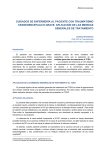
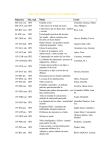

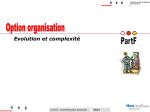
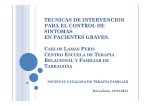
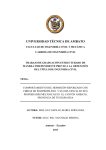
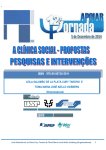

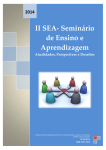
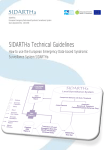
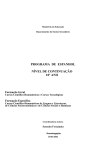
![ELSA & FRED - Cinéma[s] LE FRANCE](http://vs1.manualzilla.com/store/data/006461598_1-951252b1c2698bd8448de6db13b52e04-150x150.png)
